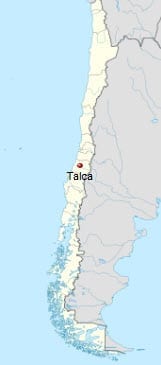 According to catastrophe modeling firm AIR Worldwide, yesterday evening, a M7.1 earthquake struck central Chile approximately 27 kilometers north-northwest of the city of Talca (approximate population of 200,000). According to the United States Geological Survey (USGS), the earthquake occurred at 7:37 PM local time (22:37:06 UTC) and struck at a depth of 34.8 kilometers.
According to catastrophe modeling firm AIR Worldwide, yesterday evening, a M7.1 earthquake struck central Chile approximately 27 kilometers north-northwest of the city of Talca (approximate population of 200,000). According to the United States Geological Survey (USGS), the earthquake occurred at 7:37 PM local time (22:37:06 UTC) and struck at a depth of 34.8 kilometers.
“The earthquake occurred on the subduction zone that was partially ruptured by the 2010 earthquake; it can therefore be considered another aftershock of the 2010 earthquake,” said Dr. Tao Lai, principal engineer at AIR Worldwide. “It is located in the epicentral area of the 1928 M7.5 earthquake.”
As a precaution, officials ordered approximately 25,000 coastal residents to evacuate in the Bio Bio and Maule regions, as original estimates placed the epicenter offshore in the Pacific Ocean. This same region was affected by the devastating M8.8 Maule quake in 2010, which generated a massive tsunami that wiped out parts of the coast, according to AIR. Later analysis placed yesterday’s quake onshore, which prompted Chile’s emergency officials to cancel the tsunami warning.
The USGS estimates that more than 800,000 people experienced strong shaking (Modified Mercalli Index of VI) and 9000 people experienced very strong shaking (MMI of VII) in the Maule region. Moderate shaking was felt in Chile’s capital of Santiago (more than 200 kilometers north of the epicenter), where buildings swayed from side to side for some 20 seconds. No major damage has been reported in the affected area, including near the epicenter. Falling debris has caused a few minor injuries and there are reports of traffic accidents and landslides. The quake caused massive power outages and disruptions to mobile communications.
According to AIR, reported building damage has typically been nonstructural in nature, mostly to roofs and ceilings. Chile’s long history of damaging earthquakes has resulted in a strict building code, which is generally well enforced in cities. However, many buildings in rural locations and historic town centers are older structures constructed of adobe. These are widespread in the epicentral region and typically do not adhere to the country’s building code; they are characterized by poorer seismic performance than modern buildings. However, because of earthquake awareness, these adobe structures were typically built with very thick walls embedded with wood rods and straw and generally show more seismic resistance than similar construction in other regions of the world.
According to AIR, in 2010, the Maule earthquake off Chile’s coast caused significant damage to thousands of older adobe structures. Damage to adobe structures was not reported yesterday, however, in part due to the weaker magnitude of yesterday’s quake.
AIR does not expect significant insured losses from this event.
